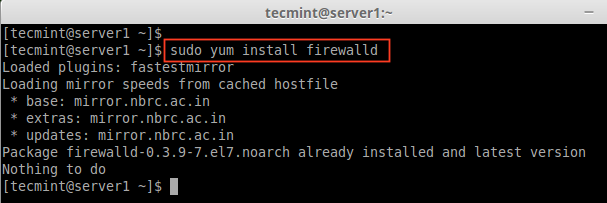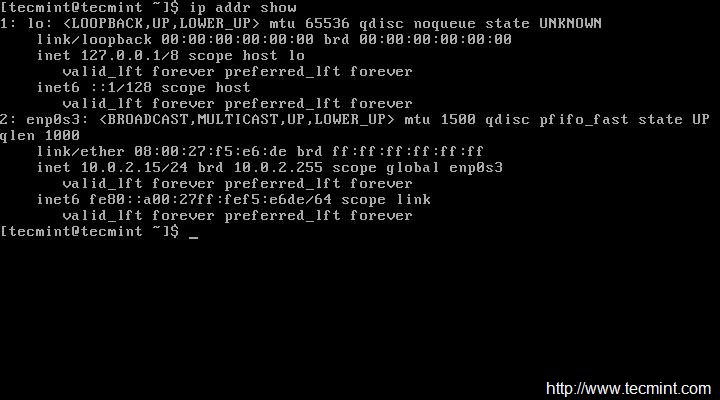On this page
- Centos 7 Documentation
- Centos 7 Installation Guide
- Install Qmail On Centos 7 Change Static Ip Windows 10
Prometheus is an open source monitoring system that allows you to collect metrics from any configured target system. Prometheus implements a multi-dimensional, and all prometheus services will be running under the prometheus user.
Create new 'prometheus' user using the command below.
By default, CentOS 7 network interfaces are disabled. This video shows 2 methods to enable network interface and configure static IP address on CentOS 7 which are as following: 1. Configure IP.
A new user has been created. Now log in to the user and download prometheus using the wget command.
Extract the prometheus-xx.x.x.tar.gz file and rename the directory to 'prometheus'.
Prometheus is downloaded to the server, and all prometheus files are on the '/home/prometheus/prometheus' directory.
Step 2 - Configure Prometheus As a Systemd Service
In this step, we will configure prometheus as a systemd service. We will create a new service file prometheus.service on the '/etc/systemd/system' directory.
Go to the '/etc/systemd/system/' directory and create new service file 'prometheus.service' using vim editor.
Paste the prometheus service configuration below.
Save and exit.
Now reload the systemd system using the systemctl command below.
Start the prometheus service and enable it to launch everytime at system startup.
The prometheus is now running as a systemd service, check it using the command below.
Make sure you get the 'Running' service status.
Or check it using the netstat command below.
Make sure you get the result as shown below.
Prometheus is running by default under the port '9090'.

Step 3 - Configure Firewalld
If you're using Firewalld on your system, add the port 9090 to the Firewalld list ports.
Open port 9090 for the Prometheus access using firewall-cmd commands below.
Now open your web browser and type the server IP address with port 9090.
http://192.168.33.10:9090/graph
Type 'http_requests_total' in the query field and click the 'Execute' button.
And you will see HTTP requests to the prometheus server with all info about the time, HTTP status code, and method etc.
Step 4 - Install and Configure node_exporter
node_exporter is an exporter of machine metrics that can run on *Nix and Linux system.
In this tutorial, we will install the node_exporter on the same server prometheus. We will monitor and get the metric of the prometheus server.
Login to the prometheus user and download the 'node_exporter' using the wget command.
Extract the node_exporter and rename the directory to 'node_exporter'.
Next, we will create new service file for the node_exporter. Back to the root shell, goto the '/etc/systemd/system' directory and create new node_exporter service file 'node_exporter.service' using vim.
There, paste node_exporter service configuration below.
Save and exit.
Now reload the systemd system.
Then start the node_exporter service and enable it to launch everytime at system startup.
The node_exporter service is now running on the server - check it using the netstat command.
And you will get the node-exporter is running on port 9100.
Step 5 - Add node_exporter to the Prometheus Server
In this step, we will add the node_exporter to the prometheus server. Login to the prometheus user and edit the configuration 'prometheus.yml' file.
Login to the prometheus user.
Goto the 'prometheus' directory and edit the configuration file 'prometheus.yml'.
Under the 'scrape_config' line, add new job_name node_exporter by copy-pasting the configuration below.
Save and exit.
Now restart the prometheus service.
The node_exporter has been added to the prometheus server.
Step 6 - Testing Prometheus and node_exporter
Open your web browser and then input the server IP address.
http://192.168.33.10:9090/
Type the meminfo collector 'node_memory_MemAvailable_bytes' in the query field and click the 'Execute' button.
And you will get the result as below.
You will get the available memory on the server instance 'localhost:9100', and the job_name 'node-exporter'.
Centos 7 Documentation
Or if you want to access the node_exporter raw data, you need to add the node_exporter port 9100 to the firewalld.
And then type the server IP address with port 9100.
http://192.168.33.10:9100/metrics
The Export to MicroStation DGN process doesn't always work. Autocad civil 3d line types worksheet.
And you will get the node_exporter raw data as shown below. Parks and recreation cast.
Installation and configuration of the prometheus monitoring system with the node_exporter on CentOS 7 has been completed successfully.

Step 3 - Configure Firewalld
If you're using Firewalld on your system, add the port 9090 to the Firewalld list ports.
Open port 9090 for the Prometheus access using firewall-cmd commands below.
Now open your web browser and type the server IP address with port 9090.
http://192.168.33.10:9090/graph
Type 'http_requests_total' in the query field and click the 'Execute' button.
And you will see HTTP requests to the prometheus server with all info about the time, HTTP status code, and method etc.
Step 4 - Install and Configure node_exporter
node_exporter is an exporter of machine metrics that can run on *Nix and Linux system.
In this tutorial, we will install the node_exporter on the same server prometheus. We will monitor and get the metric of the prometheus server.
Login to the prometheus user and download the 'node_exporter' using the wget command.
Extract the node_exporter and rename the directory to 'node_exporter'.
Next, we will create new service file for the node_exporter. Back to the root shell, goto the '/etc/systemd/system' directory and create new node_exporter service file 'node_exporter.service' using vim.
There, paste node_exporter service configuration below.
Save and exit.
Now reload the systemd system.
Then start the node_exporter service and enable it to launch everytime at system startup.
The node_exporter service is now running on the server - check it using the netstat command.
And you will get the node-exporter is running on port 9100.
Step 5 - Add node_exporter to the Prometheus Server
In this step, we will add the node_exporter to the prometheus server. Login to the prometheus user and edit the configuration 'prometheus.yml' file.
Login to the prometheus user.
Goto the 'prometheus' directory and edit the configuration file 'prometheus.yml'.
Under the 'scrape_config' line, add new job_name node_exporter by copy-pasting the configuration below.
Save and exit.
Now restart the prometheus service.
The node_exporter has been added to the prometheus server.
Step 6 - Testing Prometheus and node_exporter
Open your web browser and then input the server IP address.
http://192.168.33.10:9090/
Type the meminfo collector 'node_memory_MemAvailable_bytes' in the query field and click the 'Execute' button.
And you will get the result as below.
You will get the available memory on the server instance 'localhost:9100', and the job_name 'node-exporter'.
Centos 7 Documentation
Or if you want to access the node_exporter raw data, you need to add the node_exporter port 9100 to the firewalld.
And then type the server IP address with port 9100.
http://192.168.33.10:9100/metrics
The Export to MicroStation DGN process doesn't always work. Autocad civil 3d line types worksheet.
And you will get the node_exporter raw data as shown below. Parks and recreation cast.
Installation and configuration of the prometheus monitoring system with the node_exporter on CentOS 7 has been completed successfully.
Reference
Background information:I have a problem installing system-config-network. It appears it cannot find an update to sqlite (checks every mirror and comes back empty handed.) I have tried the skipping broken option and package cleanups from yum-utils.
Since I cannot get it installed, I decided to set an ip manually from console. A quick Google search comes back empty handed as for an easy how-to guide that works. What do I need to do for a currently configured DHCP ip to change it to a Static IP from console.
Thanks,Josh
Joshua EnfieldJoshua Enfield2 Answers
Edit the /etc/sysconfig/network-scripts/ifcfg-eth[num] file like this:
When you are done run /etc/init.d/network restart.
Centos 7 Installation Guide
PowerSp00nPowerSp00nLook at the config files in /etc: /etc/sysconfig/network and /etc/sysconfig/network-scripts/ifcfg-ethx
moshenmoshen